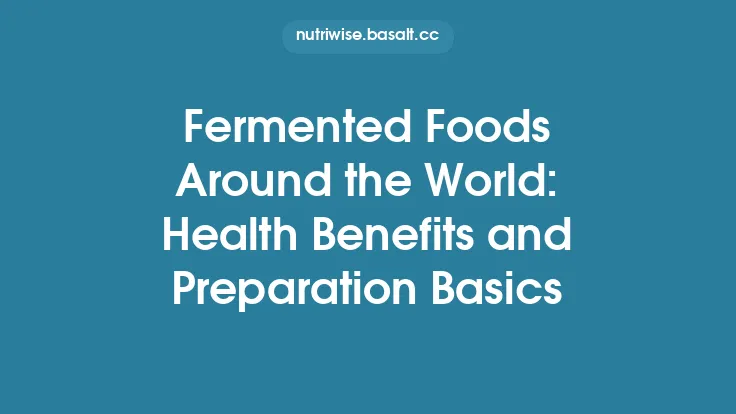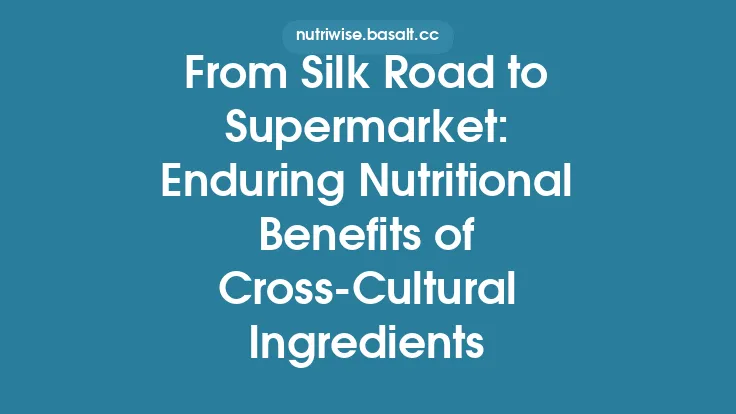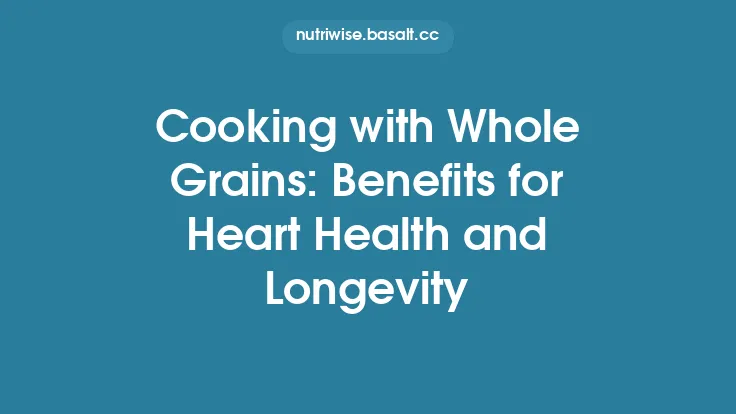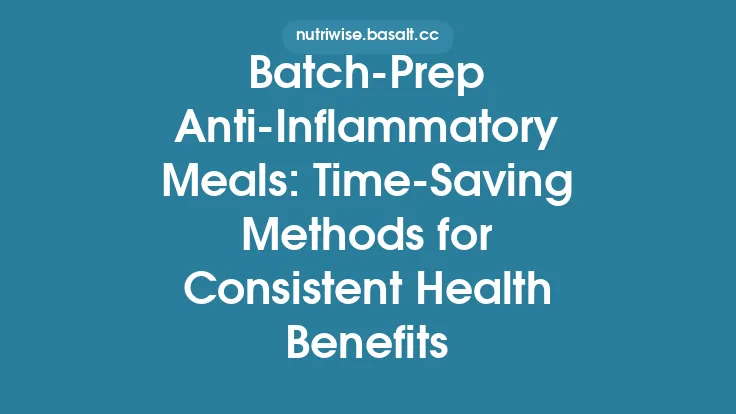Cross‑cultural cooking techniques have been refined over centuries, each region developing methods that not only enhance flavor but also promote health. While the ingredients vary widely, the underlying principles of how food is transformed in the kitchen often converge on similar physiological benefits. Understanding these techniques provides a roadmap for anyone seeking to adopt a more nutritious, globally‑inspired diet.
Fermentation: Harnessing Microbial Power
Fermentation is a cornerstone of many culinary traditions—from Korean kimchi and Japanese miso to Ethiopian injera and German sauerkraut. The process relies on lactic‑acid bacteria, yeasts, or molds to break down complex carbohydrates, proteins, and lipids into more digestible forms.
- Probiotic enrichment – Live cultures introduced during fermentation colonize the gut, supporting a balanced microbiome, enhancing immune function, and reducing inflammation.
- Enhanced bioavailability – Fermentation can increase the levels of vitamins B₂, B₁₂, K₂, and certain B‑complex vitamins, while also liberating minerals such as calcium, magnesium, and iron from phytate complexes.
- Reduced antinutrients – Phytic acid, oxalates, and certain enzyme inhibitors are degraded, making nutrients more accessible and decreasing the risk of mineral deficiencies.
Technical note: The optimal pH for lactic‑acid fermentation lies between 3.5 and 4.0. Maintaining this range inhibits pathogenic microbes while encouraging beneficial strains such as *Lactobacillus plantarum and Leuconostoc mesenteroides*.
Steaming and Its Nutrient‑Preserving Advantages
Steaming is prevalent in Chinese dim sum, Southeast Asian fish dishes, and West African vegetable preparations. By exposing food to saturated steam rather than direct water contact, this method minimizes leaching of water‑soluble nutrients.
- Retention of vitamins – Vitamin C and B‑vitamins, which are heat‑sensitive and water‑soluble, are better preserved compared to boiling.
- Low‑fat cooking – No added oil is required, resulting in lower caloric density while retaining the natural flavors of the food.
- Gentle protein denaturation – Steaming causes a gradual unfolding of protein structures, preserving essential amino acids and reducing the formation of advanced glycation end‑products (AGEs) that are linked to oxidative stress.
From a thermodynamic perspective, steam transfers heat at a latent heat of vaporization of 2260 kJ kg⁻¹, allowing rapid temperature rise without excessive temperature spikes that could degrade delicate nutrients.
Grilling and Charcoal Techniques: Balancing Flavor and Health
Grilling over open flame is a hallmark of Argentine asado, Middle Eastern kebabs, and South‑East Asian satay. While high temperatures can generate desirable Maillard‑derived flavors, they also pose potential health concerns if not managed properly.
- Maillard reaction benefits – The browning process creates flavor compounds such as pyrazines and furans, which can stimulate appetite and improve satiety.
- Controlled charring – Limiting direct flame contact and avoiding prolonged exposure reduces the formation of heterocyclic amines (HCAs) and polycyclic aromatic hydrocarbons (PAHs), both of which have been implicated in carcinogenesis.
- Fat rendering – Grilling allows excess fat to drip away, decreasing overall caloric intake while preserving lean protein.
Practical tip: Marinating meat in acidic solutions (e.g., lemon juice, vinegar) for 30 minutes to 2 hours can reduce HCA formation by up to 50 % due to the antioxidant activity of phenolic compounds present in many marinades.
Stir‑Frying and High‑Heat Quick Cooking
Stir‑frying, popularized in Chinese wok cooking, is a rapid method that combines high heat with constant motion. This technique offers several health‑promoting attributes:
- Nutrient lock‑in – The brief cooking window (often 2–5 minutes) limits exposure to heat, preserving heat‑sensitive vitamins and phytonutrients.
- Reduced oil usage – A small amount of high‑smoke‑point oil (e.g., peanut, grapeseed) suffices, delivering essential fatty acids without excessive caloric load.
- Enhanced antioxidant activity – Certain vegetables, such as broccoli and bell peppers, exhibit increased levels of glucosinolates and carotenoids after brief high‑heat exposure.
From a culinary physics standpoint, the wok’s curved shape creates a “vortex” of hot air, allowing food to cook at temperatures up to 250 °C while minimizing oil temperature fluctuations.
Slow Cooking and Low‑Temperature Methods
Slow cooking, whether in a Dutch oven, tagine, or modern electric crockpot, utilizes low, sustained heat over extended periods. This method is central to dishes like Moroccan tagine, Mexican barbacoa, and Indian dal.
- Collagen conversion – Prolonged heat transforms collagen in tough cuts of meat into gelatin, improving digestibility and providing a source of glycine, an amino acid beneficial for joint health.
- Increased mineral extraction – Slow simmering releases minerals from bones and legumes, enriching broths with calcium, phosphorus, and magnesium.
- Reduced formation of harmful compounds – Lower cooking temperatures (typically 80–100 °C) limit the generation of AGEs compared with high‑heat methods.
A key consideration is maintaining a stable temperature; fluctuations can cause protein denaturation that leads to texture loss and nutrient degradation.
Baking and Roasting Across Cultures
Baking and roasting are ubiquitous, from Mediterranean flatbreads to North African couscous and Scandinavian rye loaves. These dry‑heat methods rely on convection currents within an oven to evenly distribute heat.
- Complex carbohydrate development – The gradual caramelization of starches yields resistant starches, which act as prebiotics, feeding beneficial gut bacteria.
- Fiber preservation – Whole‑grain baking retains dietary fiber, supporting satiety and glycemic control.
- Vitamin D synthesis (in sun‑exposed breads) – Traditional sun‑baked flatbreads can acquire modest amounts of vitamin D through UV exposure of the dough surface, though this contribution is minor compared to dietary sources.
When baking at temperatures above 180 °C, it is advisable to incorporate a modest amount of acidic ingredients (e.g., yogurt, sourdough starter) to counteract potential oxidative stress on lipids.
Smoking and Curing: Traditional Preservation with Health Considerations
Smoking is a time‑honored preservation technique found in Scandinavian gravlax, Native American smoked fish, and South American smoked meats. While it imparts unique flavors, the health impact hinges on method and duration.
- Antimicrobial effect – Phenolic compounds in wood smoke inhibit bacterial growth, extending shelf life without refrigeration.
- Potential PAH exposure – Direct exposure to smoke can deposit polycyclic aromatic hydrocarbons; however, using indirect smoking (cold smoking) and selecting hardwoods low in resin reduces this risk.
- Omega‑3 retention – Smoking fatty fish (e.g., salmon) preserves omega‑3 fatty acids, which are susceptible to oxidation in other high‑heat processes.
Modern adaptations include using liquid smoke or controlled smoke generators that deliver consistent flavor while limiting harmful by‑products.
Cooking with Minimal Oil: Techniques from the Mediterranean to East Asia
Many cultures have devised ways to achieve richness without heavy oil use. Examples include the Mediterranean practice of poaching vegetables in broth, Japanese *nimono (simmered dishes), and Indian tadka* (tempered spices) where a small amount of oil is used to release flavor compounds.
- Reduced caloric density – Limiting oil to ≤5 g per serving cuts calories by roughly 45 kcal while still delivering essential fatty acids.
- Preservation of heat‑sensitive nutrients – Lower oil temperatures prevent oxidation of polyunsaturated fatty acids, maintaining their anti‑inflammatory properties.
- Flavor amplification – Techniques such as deglazing and using aromatics (garlic, ginger, herbs) can compensate for reduced fat, enhancing satiety signals via the release of volatile compounds that stimulate the olfactory system.
Integrating Whole Grains and Legumes Through Traditional Methods
Whole grains and legumes are staples across continents, yet their nutritional potential is often unlocked through specific preparation methods.
- Soaking and sprouting – Soaking beans for 8–12 hours and allowing them to sprout for 2–3 days activates endogenous enzymes (e.g., phytase) that degrade phytic acid, improving mineral absorption.
- Parboiling and toasting – In West African and South Asian cuisines, parboiling grains before final cooking reduces cooking time and gelatinizes starches, enhancing digestibility.
- Fermented grain batters – Ethiopian injera and South Indian dosa use fermented batter, which not only introduces probiotics but also increases the bioavailability of B‑vitamins and reduces glycemic response.
These practices illustrate how traditional culinary wisdom aligns with modern nutritional science.
The Role of Utensils and Cookware in Health Outcomes
The material composition of cookware can influence nutrient retention and the formation of unwanted compounds.
- Cast iron – Cooking acidic foods (tomato‑based sauces) in seasoned cast iron can increase dietary iron, beneficial for individuals with iron‑deficiency anemia.
- Stainless steel – Non‑reactive and durable, it prevents leaching of metals while allowing high‑temperature searing without imparting off‑flavors.
- Clay and ceramic – Used in Mexican *molcajete* or Moroccan tagine, these porous vessels retain moisture, reducing the need for added fats and preserving volatile aromatics.
- Non‑stick surfaces – Modern PTFE‑based coatings enable low‑oil cooking but should be used at moderate temperatures (<260 °C) to avoid polymer degradation.
Choosing appropriate cookware for each technique maximizes health benefits while preserving culinary authenticity.
Cross‑Continental Comparative Insights
| Technique | Primary Regions | Core Health Benefit | Key Nutrient Impact |
|---|---|---|---|
| Fermentation | East Asia, Europe, Africa | Probiotic enrichment, antinutrient reduction | ↑ B‑vitamins, ↑ mineral bioavailability |
| Steaming | East Asia, West Africa | Nutrient preservation, low‑fat | ↑ vitamin C, ↑ water‑soluble B‑vitamins |
| Grilling (direct) | South America, Middle East, Southern Africa | Fat reduction, flavor development | ↓ total fat, potential ↑ HCAs (mitigated by marinades) |
| Stir‑frying | China, Southeast Asia | Rapid cooking, antioxidant boost | ↑ carotenoids, minimal vitamin loss |
| Slow cooking | North Africa, Latin America, South Asia | Collagen conversion, mineral extraction | ↑ gelatin, ↑ calcium/phosphorus in broths |
| Baking/Roasting | Europe, Middle East, North America | Resistant starch formation, fiber retention | ↑ dietary fiber, ↑ resistant starch |
| Smoking | Scandinavia, Indigenous Americas, East Asia | Preservation, omega‑3 retention | ↑ phenolic antimicrobials, potential PAHs (controlled) |
| Minimal‑oil poaching/simmering | Mediterranean, Japan | Calorie reduction, flavor concentration | ↓ lipid oxidation, ↑ volatile aroma compounds |
These patterns reveal that while the cultural context varies, the physiological outcomes often converge: enhanced nutrient availability, reduced harmful compounds, and improved satiety.
Practical Takeaways for Modern Home Cooks
- Mix techniques – Combine steaming vegetables with a quick stir‑fry to lock in nutrients and add texture.
- Mind the heat – Use high heat for brief periods (stir‑fry, wok) or low, steady heat for prolonged cooking (slow braise) to balance flavor and health.
- Leverage fermentation – Start with simple projects like sauerkraut or kefir; they require minimal equipment and deliver probiotic benefits.
- Select appropriate cookware – Match the material to the method—cast iron for searing, ceramic for slow cooking, stainless steel for sautéing.
- Control exposure to smoke and char – Marinate, use indirect grilling, and limit direct flame contact to keep HCAs and PAHs low.
- Incorporate whole grains and legumes – Soak, sprout, or ferment them before cooking to maximize digestibility and nutrient uptake.
- Use herbs and spices wisely – While this article avoids deep discussion of spice trade, adding fresh aromatics can enhance flavor without extra fat or sodium.
By integrating these time‑tested techniques into everyday meals, cooks can enjoy the rich tapestry of global culinary traditions while reaping measurable health benefits. The synergy of method, material, and mindful preparation creates a diet that is both delicious and nutritionally robust—an enduring legacy of cross‑cultural cooking.





